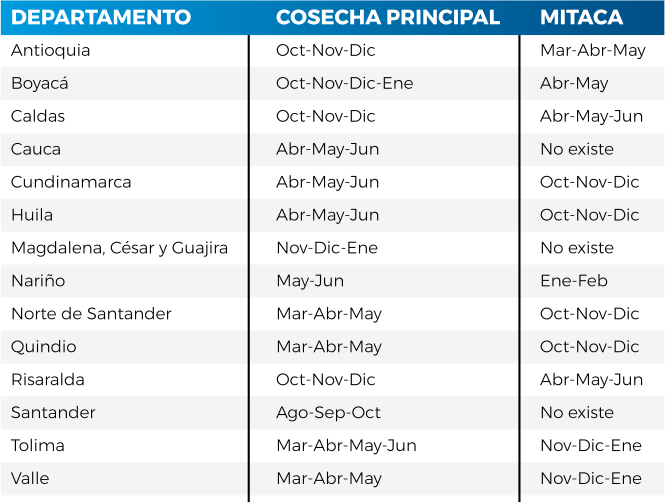TYPES OF COFFEE AND SURFACE WITH PLANTATIONS

Colombia has a land area of 113,891,400 hectares, of which 7,300,000 are ready for coffee production.
For years the country has been consolidated internationally for having the best coffees for its aroma and flavor. This is due to the fact that grains of the Coffee Arabica L plant are produced, which has a variety of coffee types that are sown in Colombian soils: Típica, Bourbon, Caturra, Maragogipe and Variedad Colombia. The latter was created by the Centro de Investigaciones de Café, Cenicafé- Coffee Research Center, to make this type of plant resistant to rust, a disease that affects crops.
In 1997, the Federación Nacional de Cafeteros de Colombia-National Federation of Coffee Growers of Colombia counted that 563 municipalities of the country are coffee producers. These specialize in planting different types of coffee due to soils and climates.
SOIL CONDITIONS
For coffee trees to grow and bear fruit, they must be planted in deep, loamy soils with a granular structure, moderate permeability and well aired.
In territories such as the coffee zone, volcanic ash materials have played an important role in the evolution of the soils that have made them more productive.
However, the most important thing is that these soils that have a moderate fertility, are treated with fertilizers and organic products to prevent erosion and the low quality of their grains.

WEATHER

Altitude: Coffee crops are grown by planting them at a height between 1,100 meters and 1,700 meters above sea level.
Temperature: Coffee zones must have an average temperature between 18 ° C and 24 ° C.
Humidity: Coffee plants are planted in regions that have an average between 70 and 80% with high alterations between day and night.
Precipitation: In Colombia there are four areas of crops: the mountainous, central zone and northern and southern regions. The first one, presents between 2,000 and 2,500 millimeters per year. The second one, has two rainy periods during the months of April-May and October-November, (this is considered the best area for coffee) and finally in the northern and southern regions, there is only one large rainy period that is September -October November.
Sunlight: The best coffee zones in the country present on average 150 hours of sunshine per month. On the other hand, there are crops in warmer areas with dry months where the brightness can reach 208 hours a month while in colder temperatures in total you can reach only 70 hours of sunshine per month.
CULTIVATION PROCESS HARVEST PERIODS
Once the seed is in the earth, its germination happens after 45-50 days, that little outbreak is called matches. The first leaves grow 15 days later and then they are transplanted in black bags to the almacigo, a structure that protects the future trees from the sun and the rain. Then, when the trees have between 150-180 days they are moved to the field.
The Colombian topography means that coffee is planted mainly on hillsides and that its collection is manual. When the coffee trees have between 540-600 days, the first flowering occurs and in an interval of three to four months the first ripe fruit is produced. With the purpose of improving the quality, collectors only extract from the plant the red grains, also called cherries.
After that, the grains are washed in a method called ‘Benefit’ – a popular technique in the country, which consists on removing the cherries that float and leaving to fermentation the ones at the bottom between 18-24 hours. With this, the mucilage dissolves and the clean grain is left to dry. However, some companies in their process of innovation and sustainability use the method in a more ecological way reducing water usage by 72%.
The drying process is carried out in the sun. However, some farms use ovens that work with energy, coal or wood to dry. Then, when the grain has reached a 12% humidity, the next step is the procedure of removing the parchment and leaving the green grain ready to be sorted by sorting machines that do it by size and weight. This systematization allows to finally obtain the exportable coffee. Learn about coffee harvest times in different regions of Colombia:

HARVEST PERIODS

Learn about coffee harvest times in different regions of Colombia: :




